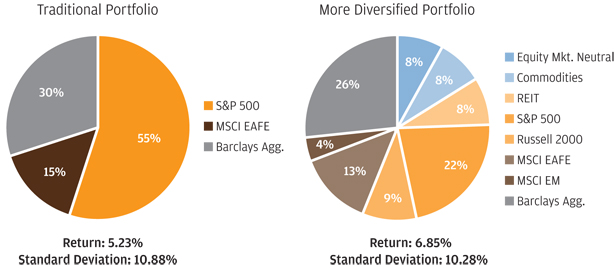In today’s investment world, there are dozens of investment products and strategies out there to choose from. It’s understandable that investors might get overwhelmed when trying to decide which option or combination of options seems like the right choice for them.
But amidst all the variables, there’s one thing we encourage investors to remember and fall back on: it’s not so much about the products and strategies themselves; it’s how you allocate your portfolio across different areas of the market.
The old fashioned approach still holds true: a properly diversified portfolio can provide better returns with less risk over time.1
The Power of a Properly Diversified Portfolio
You’ve probably heard before that a properly diversified portfolio can give you a good chance at achieving solid returns with reduced risk. The plain and simple truth? The power of that investment philosophy hasn’t changed (note: standard deviation represents risk):
Maximizing the Power of Diversification (1999 - 2013)
(Click chart for larger version)
Source: JP Morgan Asset Management. Indexes and weights of the traditional portfolio are as follows: U.S. stocks: 55% S&P 500, U.S. bonds: 30% Barclays Capital Aggregate, International stocks: 15% MSCI EAFE. Portfolio with 25% in alternatives is as follows: U.S. stocks: 22.2% S&P 500, 8.8% Russell 2000; International Stocks: 4.4% MSCI EM, 13.2% MSCI EAFE; U.S. Bonds: 26.5% Barclays Capital Aggregate; Alternatives: 8.3% CS/Tremont Equity Market Neutral, 8.3% DJ/UBS Commodities, 8.3% NAREIT Equity REIT Index. Return and standard deviation calculated using Morningstar Direct. Charts are shown for illustrative purposes only. Past returns are no guarantee of future results. Diversifi cation does not guarantee investment returns and does not eliminate risk of loss. Data as of December 31, 2013.
A More Diversified Portfolio Produced Better Returns with Lower Risk
Over the last 18 years, better returns have come with more diversification, and we don’t envision the next 18 years being any different.
A properly diversified portfolio can give investors a better chance of ensuring they capture returns of the top performing asset classes each year, while also not suffering disproportionate losses because they’re overexposed to the worst performing asset. Taking a balanced approach helps smooth out returns and reduce risk.
Diversifying Your Portfolio is a Two-Part Process
The charts make it look easy—diversify across more asset classes and receive a higher rate of return with lower risk. But we actually think it’s a bit more nuanced than that, and we have two steps for investors to take to make it work:
- Remember Your Diversified Portfolio is a Long-Term Solution: There will likely be times when an investor sees a weak performing part of their portfolio and wants to sell out of it in favor of a better performing piece; times when the market’s ups and downs can easily create doubt and cause an investor to seek change.
Trying to time the market often leads to underperformance over time, and can ultimately wipe away the benefits that diversification is designed to bring. - Hire Qualified Money Managers to Manage Each Piece: We wrote about this recently in a piece titled, “2 Important Steps to Diversifying Your Portfolio.” The first part is diversification across asset classes as you see in the chart, but the second part is hiring expert money managers to invest each of those asset classes. If you can manage to maximize performance of each piece of the pie, then the whole pie is more likely to deliver better results over time.
Building a Diversified Portfolio of Money Managers
WrapManager can help you accomplish both steps of the diversification process.
To get started, one of our Wealth Managers can analyze your portfolio to check its level of diversification. Then, we can use information you provide us about your financial goals to recommend an asset allocation going forward, with money managers to invest each piece of your investment portfolio for you. Give us a call at 1-800-541-7774 for a free consultation and to hear some new investment ideas. Alternatively, you can get started now by answering a few questions here.
Sources:






